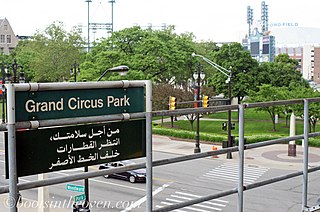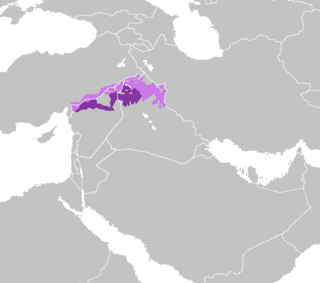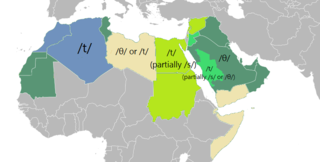 W
WAleppo Arabic or Aleppo Dialect is the urban Arabic variety spoken in the city of Aleppo.
 W
WAlgerian Saharan Arabic is a variety of Arabic indigenous to and spoken predominantly in the Algerian Sahara. Its ISO 639-3 language code is "aao," and it belongs to Maghrebi Arabic.
 W
WAnatolian Arabic is any of several varieties of Arabic spoken in Turkey. They are dialects of North Mesopotamian Arabic spoken in the Eastern Anatolia, an area comprising the Turkish provinces of Mardin, Siirt, Batman, Diyarbakır, and Muş.
 W
WArabic is the fastest-growing foreign language taught at U.S. colleges and universities, a trend mirrored at the University of Iowa.
 W
WThe blessings of Allah is a phrase used by Muslims to express thanks, typically to another person. It is one of many phrases used by Muslims to express thanks. Used also in reply to a person that says jazakallah.
 W
WBaṛī ye is a letter in the Urdu alphabet directly based on the alternative "returned" variant of the final form of the Arabic letter ye/yāʾ found in the Hijazi, Kufic and Nastaʿliq scripts. It functions as the word-final yā-ye-majhūl ([]) and yā-ye-sākin ([]). It is distinguished from the "choṭī ye ", which is the regular Perso-Arabic yāʾ (ی) used elsewhere.
 W
WThe dagger alif or superscript alif is written as a short vertical stroke on top of an Arabic letter. It indicates a long sound where alif is normally not written, e.g. هَٰذَا hādhā or رَحْمَٰن raḥmān. The dagger alif occurs in only a few modern words, but these include some common ones; it is seldom written, however, even in fully vocalised texts, except in the Qur'an. As Wright notes "[alif] was at first more rarely marked than the other long vowels, and hence it happens that, at a later period, after the invention of the vowel-points, it was indicated in some very common words merely by a fatḥa [i.e. the dagger alif.]" Most keyboards do not have dagger alif. The word ﷲ is usually produced automatically by entering "alif lām lām hāʾ". The word consists of alif + ligature of doubled lām with a shadda and a dagger alif above lām.
 W
WDhofari Arabic is a variety of Arabic, spoken in Salalah, Oman, Yemen, and the surrounding coastal regions.
 W
WDiwani is a calligraphic variety of Arabic script, a cursive style developed during the reign of the early Ottoman Turks. It reached its height of popularity under Süleyman I the Magnificent (1520–1566).
 W
WGhaflah (غفلة) is the Arabic word for negligence and heedlessness. In an Islamic context, it is the sin of forgetting Allah and one's divine origins, or being indifferent of these. It is also the sin of purposeful misguiding, misleading or the deceiving of another, usually through falsity or by failure of full disclosure, through concealment, which keeps another in ignorance and heedlessness.
 W
WGol he, also called choṭī he, is one of the two variants of the Arabic letter he/hāʾ (ه) that are in use in the Urdu alphabet, the other variant being the do-cas͟hmī he, also called hā-ye-mak͟hlūt. The letter is named for its shape in the isolated form, gol meaning "round" in Hindustani, to distinguish it from the do-cas͟hmī he, which is really a calligraphic variant of the "two-eyed" regular he in the medial position. Its various non-isolated forms originated in the Nastaʿlīq script or calligraphic hand, though various zigzag (medial) and hook (final) forms of hāʾ have existed before the script was developed.
 W
WHijazi script, also Hejazi, literally "relating to Hejaz", is the collective name for a number of early Arabic scripts that developed in the Hejaz region of the Arabian Peninsula, which includes the cities of Mecca and Medina. This type of script was already in use at the time of the emergence of Islam.
 W
WThe Jordan Academy of Arabic is one of the Arabic language regulators based in Amman, Jordan. Besides the Jordan Academy of Arabic, there are 10 other Arabic language and literature regulators in the world. It has been set up to start by 1924, but could only be in real-life by 1976.
 W
WKitab al-Aghani, is an encyclopedic collection of poems and songs that runs to over 20 volumes in modern editions, attributed to the 10th-century Arabic writer Abu al-Faraj al-Isfahani. Abu al-Faraj claimed to have taken 50 years in writing the work, which ran to over 10 000 pages and contains more than 16,000 verses of Arabic poetry. It can be seen as having three distinct sections: the first dealing with the '100 Best Songs' chosen for the caliph Harun al-Rashid, the second with royal composers and the third with songs chosen by the author himself. It spans the period from pre-Islamic times to the end of the 9th century CE. Abu al-Faraj importantly included performance directions for many of the songs included in Kitab al-Aghani. Due to the accompanying biographical annotations on the personages', the work is an important historical and historical source; it is also useful for those interested in the sociology of Arabic literature.
 W
WThe Central Kurdish variety Sorani is mainly written using an Arabic alphabet with 33 letters. Unlike the regular Arabic script, which is an abjad, Kurdish Arabic is an alphabet in which vowels are mandatory.
 W
WMashq is one of the oldest calligraphic forms of the Arabic script. At the time of the emergence of Islam, this type of writing was likely already in use in various parts of the Arabian Peninsula. It is first attested during the reign of caliph Umar, making it one of the earliest forms of Arabic script, along with Hijazi and Kufic. It was used in most texts produced during the first and second centuries after the Hijra.
 W
WMuhaqqaq is one of the main six types of calligraphic script in Arabic. The Arabic word muḥaqqaq (محقَّق) means "consummate" or "clear", and originally was used to denote any accomplished piece of calligraphy.
 W
WNorth Levantine Arabic is a subdivision of Levantine Arabic, a variety of Arabic. It stems from the north in Turkey, specifically in the coastal regions of the Adana, Hatay, and Mersin provinces, to Lebanon, passing through the Mediterranean coastal regions of Syria as well as the areas surrounding Aleppo and Damascus. It is also known as Syro-Lebanese Arabic, though that term is sometimes used to mean all of Levantine Arabic.
 W
WNorth Mesopotamian Arabic is a variety of Mesopotamian Arabic spoken north of the Hamrin Mountains in Iraq, in western Iran, northern Syria, and in southeastern Turkey. as well as in Southern Iraq by Christians and Jews. The peripheral Turkish varieties in Siirt, Muş and Batman are quite divergent. Like other Mesopotamian Arabic varieties and Levantine Arabic, it shows signs of an Aramaic substrate.
 W
WOmani Arabic is a variety of Arabic spoken in the Al Hajar Mountains of Oman and in a few neighboring coastal regions. It is the easternmost Arabic dialect. It was formerly spoken by colonists in Kenya and Tanzania, but these days, it mainly remains spoken on the island of Zanzibar.
 W
WPeninsular Arabic are the varieties of Arabic spoken throughout the Arabian Peninsula. This includes the countries of Saudi Arabia, Yemen, Oman, United Arab Emirates, Kuwait, Bahrain, Qatar, Southern Iran, and Southern Iraq.
 W
WṢaʽīdi Arabic, also known as Upper Egyptian Arabic, is a variety of Arabic spoken by the Ṣaʽīdi people in Upper Egypt, a strip of land on both sides of the Nile river that extends between Nubia and downriver (northwards) to Lower Egypt. It shares linguistic features with both Egyptian Arabic and the Quran's Classical Arabic. Dialects include Middle and Upper Egyptian Arabic.
 W
WShaddah is one of the diacritics used with the Arabic alphabet, marking a long consonant (geminate). It is functionally equivalent to writing a consonant twice in the orthographies of languages like Latin, Italian, Swedish, and Ancient Greek, and is thus rendered in Latin script in most schemes of Arabic transliteration, e.g. رُمّان = rummān 'pomegranates'.
 W
WShihhi Arabic is a variety of Arabic spoken in the Musandam Governorate of Oman and Ras al Khaimah emirate of UAE. The Al Shehhi, Al Hebsi, Al Dhuhoori and Al Shemaili tribes speak it.
 W
WSini is a calligraphic style used in China for the Arabic script. It can refer to any type of Chinese Arabic calligraphy, but is commonly used to refer to one with thick and tapered effects such as seen in Chinese calligraphy. It is used extensively in mosques in Eastern China and to a lesser extent in Gansu, Ningxia and Shaanxi.
 W
WSouth Levantine, a subdivision of Levantine Arabic, is spoken in the Southern Levant, in areas such as the Palestinian Territories, Israel as well as in most of Jordan. It is also spoken in Southern Syria, particularly in the Hauran region of Daraa Governorate.
 W
WṮāʾ (ث) is one of the six letters the Arabic alphabet added to the twenty-two from the Phoenician alphabet. In Modern Standard Arabic it represents the voiceless dental fricative, also found in English as the "th" in words such as "thank" and "thin". In Persian, Urdu, and Kurdish it is pronounced as s as in "sister" in English.
 W
WTawqi‘ is a calligraphic variety of the Arabic script. It is a modified and smaller version of the thuluth script. Both scripts were developed by Ibn Muqlah. The tawqi‘ script was further refined by Ibn al-Bawwab.
 W
WThe Tunisian Academy of Sciences, Letters and Arts is a scholarly national academy based in Tunis. It is housed officially in a mid-19th century palace, Zarrouk Palace, situated on the Mediterranean coast at the base of the ruins of ancient Carthage. It is a member academy of the Union Académique Internationale.
 W
WUN Arabic Language Day is observed annually on December 18. The event was established by the UN Educational, Scientific and Cultural Organization (UNESCO) in 2010 seeking "to celebrate multilingualism and cultural diversity as well as to promote equal use of all six of its official working languages throughout the organization". December 18 was chosen as the date for the Arabic language as it is "the day in 1973 when the General Assembly approved Arabic as an official UN language".
 W
WUnited Nations Security Council Resolution 528, adopted on December 21, 1982, after the General Assembly passed Resolution 3190 extolling the virtues of expanded working languages, the Council decided to include Arabic among the working languages of the Security Council.
 W
WVe ڤ is a letter of the Arabic-based Central Kurdish, Comoro, Wakhi, and Karakhanid alphabets. It is derived from the Arabic letter fāʾ (ف) with two additional dots. It represents the sound in the aforementioned uses.
 W
WWestern Morocco Arabic, Western Moroccan Arabic or ʿAroubi Arabic is a dialectal continuum of Hilalian Arabic, mainly spoken in the plains of western and central-western plains of Morocco.